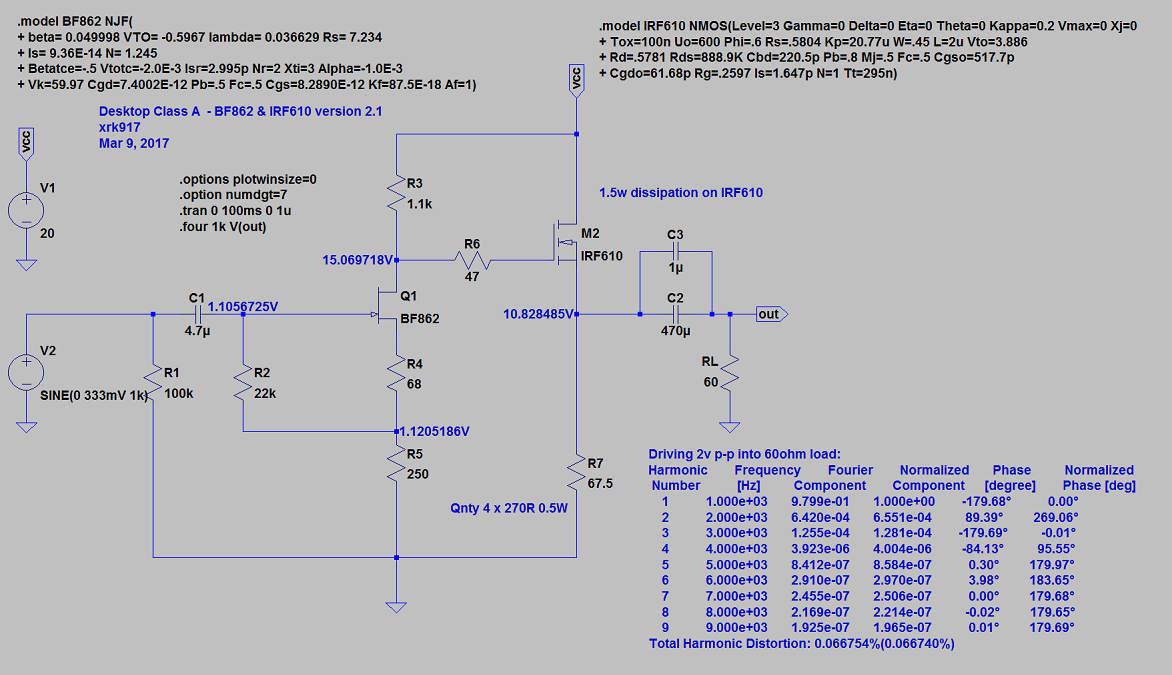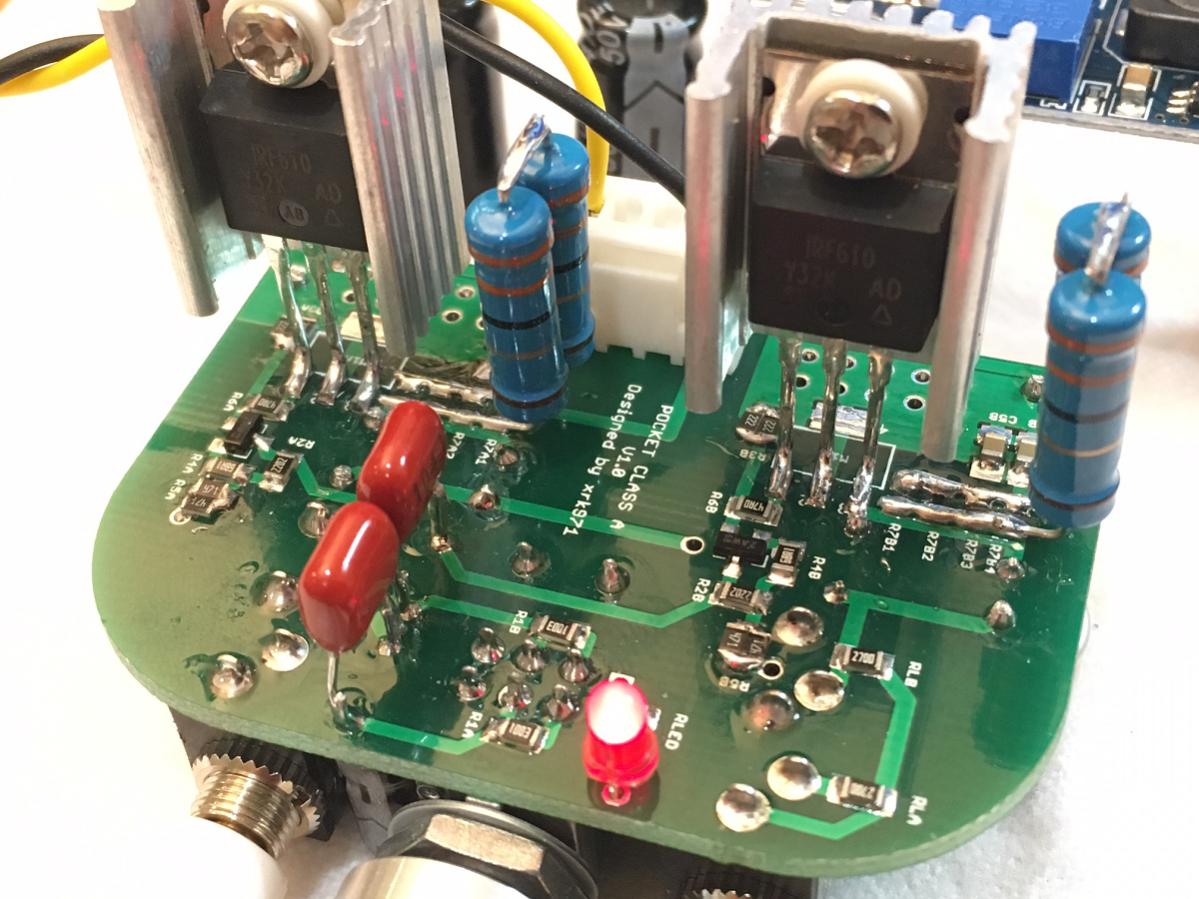You are using an out of date browser. It may not display this or other websites correctly.
You should upgrade or use an alternative browser.
You should upgrade or use an alternative browser.
New DIY Altoids Tin Amp - The Pocket Class A "Wintergreen Handwarmer" by xrk971
- Thread starter stellarelephant
- Start date
Perhaps JFET is fine and R5 is either failed or has cold solder joint. The attached sim shows a bad R5 (open) gives 14.8v on all pins of JFET and 12v on S of MOSFET.
So check R5's resistance relative to GND, check that it is connected to R4, and check to see if it is connected to GND on one end.

bad news, I accidentally reversed polarity of the power supply and blew up MOSFET B's S pin, and I suspect the other MOSFET is also damaged.
but X, i think you are correct, I touched up all of the joints of FETs and R2, R3, R4, R5, and R7s and I am getting normal measurements like you stated previously on the JFET pins and across R3
strangely I am even getting the correct readings on both MOSFET's pins even tho one of them has a visible burnt mark.
I still plugged my DAP just to give it a try and got silence on the right channel and a high pitched hum on the left.
I guess i'll start on my 2nd board because I had trouble removing the MOSFETs on the first board.
pretty bummed about the two damaged mosfets =(((
Last edited:
EDIT: double posted...
xrk971
Member of the Trade: XRKAudio
Sorry to hear you burnt it out - it doesn't always kill an amp to apply reverse polarity. I have done that myself on a big 90w amp and smelled smoke from the wires after 2 seconds. But amp was fine. We all do this sooner or later so don't feel too bad. Glad the DC voltages are checking out - that means your JFETs are probably OK. No sound probably means MOSFETs are bad - gates are probably burned now because this amp does not have protective zener diodes to clamp the gates.
Sorry to hear you burnt it out - it doesn't always kill an amp to apply reverse polarity. I have done that myself on a big 90w amp and smelled smoke from the wires after 2 seconds. But amp was fine. We all do this sooner or later so don't feel too bad. Glad the DC voltages are checking out - that means your JFETs are probably OK. No sound probably means MOSFETs are bad - gates are probably burned now because this amp does not have protective zener diodes to clamp the gates.
i found a lot of MOSFETs from the parts bin at work, is there any spec I should be looking for, maybe I can find suitable replacements by any chance?
DutchGFX
1000+ Head-Fier
- Joined
- Dec 1, 2012
- Posts
- 1,452
- Likes
- 50
i found a lot of MOSFETs from the parts bin at work, is there any spec I should be looking for, maybe I can find suitable replacements by any chance?
Can you also find surface mount resistors? If so, you can always replace the source resistor to match whatever MOSFETS you choose. Again, I defer to X, but most high current MOSFETS should work if they have suitable threshold voltages. The second stage is just a voltage buffer with near 100% negative feedback, so you will be more or less OK if you use any MOSFETS that can drive your cans, but, again, I didn't design it, so it's hard for me to say
Last edited:
xrk971
Member of the Trade: XRKAudio
Most N channel MOSFETs can work with some tweaking but it requires a simulation to determine the DC set points which then determine the resistor values. It's easier to just order more $1.12ea (for 10) ZVN4306GTA's from Mouser. I have a desktop amp that uses IRF610's but the resistors are all different and took me several days of playing with LTSpice to get the values where I wanted them to obtain the sonic signature characteristic is this amp. Change the mosfet or the resistors and it's a different sounding amp. I can't say if it will sound as good but chances are it won't as it takes a lot of effort to tune the circuit.
You should buy about a dozen at least - discount on 10 or more and you can then match them.
http://www.mouser.com/ProductDetail...=/ha2pyFaduhzzzbly3RCiMvYTDV/uGN047TrGWvUbjs=
You should buy about a dozen at least - discount on 10 or more and you can then match them.
http://www.mouser.com/ProductDetail...=/ha2pyFaduhzzzbly3RCiMvYTDV/uGN047TrGWvUbjs=
Last edited:
Can you also find surface mount resistors? If so, you can always replace the source resistor to match whatever MOSFETS you choose. Again, I defer to X, but most high current MOSFETS should work if they have suitable threshold voltages. The second stage is just a voltage buffer with near 100% negative feedback, so you will be more or less OK if you use any MOSFETS that can drive your cans, but, again, I didn't design it, so it's hard for me to say
I found a box of mosfet that's labelled 60V 45A and they have K1542 markings on them
upon googling K1542, I found out it is a replacement for NTE2986
http://www.nteinc.com/specs/2900to2999/pdf/nte2986.pdf
is this remotely close in spec to ZVN4306GTA at all?

Last edited:
DutchGFX
1000+ Head-Fier
- Joined
- Dec 1, 2012
- Posts
- 1,452
- Likes
- 50
I found a box of mosfet that's labelled 60V 45A and they have K1542 markings on them
upon googling K1542, I found out it is a replacement for NTE2986
http://www.nteinc.com/specs/2900to2999/pdf/nte2986.pdf
is this remotely close in spec to ZVN4306GTA at all?

You might have a rough go trying to solder that onto the surface mount pads...
Those are much beefier transistors than the ZVN4306GTA, they could work, but it's REALLY hard to tell because I can't find a good datasheet for either variant with curves that I can interpret, which makes it rather challenging to determine the feasibility of replacement. Do you have any other NMOS available?
Attachments
xrk971
Member of the Trade: XRKAudio
It has GDS pinouts of same spacing as IRF610 which I know I was able to solder onto the board. Bend the pins to have a flat of similat length as pad (1.5mm or so) and solder it standing up. Add a local heatsink to it. The input capacitance is much larger so performance probably won't be as detailed.
But it may be worth just trying it.
Try it like this - if you have the resistors to make it a 100mA bias Desktop Amp - go for it.
http://www.diyaudio.com/forums/group-buys/302859-xrk971-pocket-class-headamp-gb-38.html#post5014544


It sounds like your PSU has buzz or hum. You need a very low ripple PSU for this amp. Super regulator or batteries are best.
But it may be worth just trying it.
Try it like this - if you have the resistors to make it a 100mA bias Desktop Amp - go for it.
http://www.diyaudio.com/forums/group-buys/302859-xrk971-pocket-class-headamp-gb-38.html#post5014544


It sounds like your PSU has buzz or hum. You need a very low ripple PSU for this amp. Super regulator or batteries are best.
Last edited:
the other closest one I found would be K942, which is a NTE2985 replacementYou might have a rough go trying to solder that onto the surface mount pads...
Those are much beefier transistors than the ZVN4306GTA, they could work, but it's REALLY hard to tell because I can't find a good datasheet for either variant with curves that I can interpret, which makes it rather challenging to determine the feasibility of replacement. Do you have any other NMOS available?
http://www.nteinc.com/specs/2900to2999/pdf/nte2985.pdf
It has GDS pinouts of same spacing as IRF610 which I know I was able to solder onto the board. Bend the pins to have a flat of similat length as pad (1.5mm or so) and solder it standing up. Add a local heatsink to it. The input capacitance is much larger so performance probably won't be as detailed.
But it may be worth just trying it.
Try it like this - if you have the resistors to make it a 100mA bias Desktop Amp - go for it.
http://www.diyaudio.com/forums/group-buys/302859-xrk971-pocket-class-headamp-gb-38.html#post5014544
It sounds like your PSU has buzz or hum. You need a very low ripple PSU for this amp. Super regulator or batteries are best.
I soldered on the K942 mofsets following X's style, but the amp doesnt turn on, i checked the battery pins and it bounces between 3V to 5V, I tried both 15V and 18V power supply, same thing.
could the stock R7 array value too far off to turn on the amp?
DutchGFX
1000+ Head-Fier
- Joined
- Dec 1, 2012
- Posts
- 1,452
- Likes
- 50
I soldered on the K942 mofsets following X's style, but the amp doesnt turn on, i checked the battery pins and it bounces between 3V to 5V, I tried both 15V and 18V power supply, same thing.
could the stock R7 array value too far off to turn on the amp?
Put your DMM in series with the PSU to measure the current. You could be drawing so much current that your PSU is sagging. Did you change any other components other than the MOSFETS?
Put your DMM in series with the PSU to measure the current. You could be drawing so much current that your PSU is sagging. Did you change any other components other than the MOSFETS?
Just the mosfets
I'll measure current tomorrow, but they are 40w power supplies tho, if two 9V batteries can power this amp... unless the new K942 mosfets draws THAT MUCH current...
I have to go pick up my kids from school now, thanks again X and DHFX! to be continued tomorrow lol
Users who are viewing this thread
Total: 2 (members: 0, guests: 2)
























